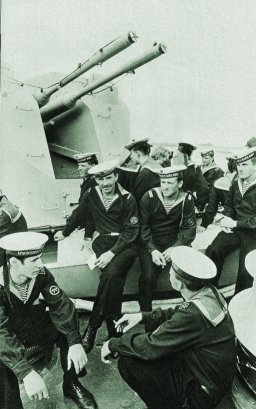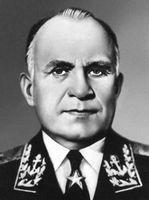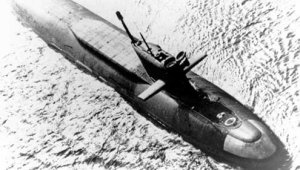|

  The flag of the Soviet Navy now proudly flies over the oceans of the world. Sooner or later the U.S. will have to understand that it no longer has mastery of the seas. The flag of the Soviet Navy now proudly flies over the oceans of the world. Sooner or later the U.S. will have to understand that it no longer has mastery of the seas.
--Admiral Sergei Gorshkov of the Soviet Navy, 1968
  From the end of the Second World War until the beginning of full-scale U.S. military involvement in Vietnam in 1965, most Americans were well aware that the United States' principal enemy in the so-called "Cold War," i.e., the nation that posed the greatest danger to America's national security, was the Soviet Union. No event made that truth more apparent than the Cuban Missile Crisis of 1962, when the two nations came uncomfortably close to nuclear annihilation. Yet from 1965 to 1973, the nation's attention was focused mainly on Southeast Asia. But though the war in Vietnam was extremely costly in both lives and money, and also received the lion's share of media attention, the gravest threat to the national security of the United States was not to be found in Hanoi but rather in Moscow, where it had always been centered since 1945. From about 1968 onward, the growth of the Soviet Navy became a particular object of concern to those who were still paying attention. From the end of the Second World War until the beginning of full-scale U.S. military involvement in Vietnam in 1965, most Americans were well aware that the United States' principal enemy in the so-called "Cold War," i.e., the nation that posed the greatest danger to America's national security, was the Soviet Union. No event made that truth more apparent than the Cuban Missile Crisis of 1962, when the two nations came uncomfortably close to nuclear annihilation. Yet from 1965 to 1973, the nation's attention was focused mainly on Southeast Asia. But though the war in Vietnam was extremely costly in both lives and money, and also received the lion's share of media attention, the gravest threat to the national security of the United States was not to be found in Hanoi but rather in Moscow, where it had always been centered since 1945. From about 1968 onward, the growth of the Soviet Navy became a particular object of concern to those who were still paying attention.
 Undesirable as a Communist takeover of the whole of Vietnam surely was, it did not pose an immediate threat or direct threat to the safety of the United States. Undesirable as a Communist takeover of the whole of Vietnam surely was, it did not pose an immediate threat or direct threat to the safety of the United States.
--Admiral Elmo R. Zumwalt, Jr., CNO (1970-1974)
The job of the men who served aboard the U.S.S. Yorktown during the fall of 1969 was to keep a close watch on Soviet submarine activity in the North Atlantic and adjacent waters, such as the North Sea, the Norwegian Sea, and the Arctic Ocean--so that in the event of a third world war, these submarines could be destroyed with nuclear depth charges before launching their nuclear missiles toward the U.S. or European mainland.
 There is no doubt...that [the Soviet Navy's] submarine force today represents the main threat to free world control of the seas in the event of hostilities. There is no doubt...that [the Soviet Navy's] submarine force today represents the main threat to free world control of the seas in the event of hostilities.
--Admiral T. H. Moorer, CNO, 19 August 1969
 Although the men of the U.S.S. Yorktown were not involved in actual combat, they put their lives on the line all the same. At sea, there is always a risk of accidents and almost certainly unknown to most of the crew was the fact that just over the horizon where it could not be seen except from the air, a Soviet guided missile cruiser continually shadowed the Yorktown, watching and waiting to take it out with nuclear missiles of its own if an actual "shooting war" started. Although the men of the U.S.S. Yorktown were not involved in actual combat, they put their lives on the line all the same. At sea, there is always a risk of accidents and almost certainly unknown to most of the crew was the fact that just over the horizon where it could not be seen except from the air, a Soviet guided missile cruiser continually shadowed the Yorktown, watching and waiting to take it out with nuclear missiles of its own if an actual "shooting war" started.
To learn more about the Soviet Navy during this era, you are invited to read the following TIME magazine articles:
Power Play on the Oceans 23 February 1968
Araments: Jane's Defensive Ships 4 October 1968
New Reality in the Mediterranean 22 November 1968
Russia: Toward a Global Reach 5 October 1970
The World: Soviet Thrust in the Mediterranean 28 June 1971
The Soviet Threat to NATO's Northern Flank 18 October 1971
Pictures courtesy Wikimedia Commons and Library of Congress.
|
![]()




 From the end of the Second World War until the beginning of full-scale U.S. military involvement in Vietnam in 1965, most Americans were well aware that the United States' principal enemy in the so-called "Cold War," i.e., the nation that posed the greatest danger to America's national security, was the Soviet Union. No event made that truth more apparent than the Cuban Missile Crisis of 1962, when the two nations came uncomfortably close to nuclear annihilation. Yet from 1965 to 1973, the nation's attention was focused mainly on Southeast Asia. But though the war in Vietnam was extremely costly in both lives and money, and also received the lion's share of media attention, the gravest threat to the national security of the United States was not to be found in Hanoi but rather in Moscow, where it had always been centered since 1945. From about 1968 onward, the growth of the Soviet Navy became a particular object of concern to those who were still paying attention.
From the end of the Second World War until the beginning of full-scale U.S. military involvement in Vietnam in 1965, most Americans were well aware that the United States' principal enemy in the so-called "Cold War," i.e., the nation that posed the greatest danger to America's national security, was the Soviet Union. No event made that truth more apparent than the Cuban Missile Crisis of 1962, when the two nations came uncomfortably close to nuclear annihilation. Yet from 1965 to 1973, the nation's attention was focused mainly on Southeast Asia. But though the war in Vietnam was extremely costly in both lives and money, and also received the lion's share of media attention, the gravest threat to the national security of the United States was not to be found in Hanoi but rather in Moscow, where it had always been centered since 1945. From about 1968 onward, the growth of the Soviet Navy became a particular object of concern to those who were still paying attention. Although the men of the U.S.S. Yorktown were not involved in actual combat, they put their lives on the line all the same. At sea, there is always a risk of accidents and almost certainly unknown to most of the crew was the fact that just over the horizon where it could not be seen except from the air, a Soviet guided missile cruiser continually shadowed the Yorktown, watching and waiting to take it out with nuclear missiles of its own if an actual "shooting war" started.
Although the men of the U.S.S. Yorktown were not involved in actual combat, they put their lives on the line all the same. At sea, there is always a risk of accidents and almost certainly unknown to most of the crew was the fact that just over the horizon where it could not be seen except from the air, a Soviet guided missile cruiser continually shadowed the Yorktown, watching and waiting to take it out with nuclear missiles of its own if an actual "shooting war" started.